I have been searching for a method to compute a distance to a convexHull/polygon such that the distance is positive if the point is within the hull and negative if outside. For example, given a hull and a set of points, can the positive/negative distance be computed?
from scipy.spatial import ConvexHull
import matplotlib.pyplot as plt
import numpy as np
# Original points, hull and test points
points = np.random.rand(30, 2) # 30 random points in 2-D
hull = ConvexHull(points)
newpoints = np.random.rand(30, 2) # 30 random points in 2-D
# Plot original points, hull and new points
plt.plot(points[:,0], points[:,1], 'ro')
plt.plot(points[hull.vertices,0], points[hull.vertices,1], 'r--', lw=2)
plt.plot(newpoints[:,0], newpoints[:,1], 'go')
So in the above I would like to calculate this signed distance for each of the green points. Thanks very much for your time!!
Update, using code from (http://www.fundza.com/vectors/point2line/index.html) can compute un-signed distance:
from scipy.spatial import ConvexHull
import matplotlib.pyplot as plt
import numpy as np
from vectors import *
# Original points, hull and test points
points = np.random.rand(30, 2) # 30 random points in 2-D
hull = ConvexHull(points)
newpoints = np.random.rand(30, 2) # 30 random points in 2-D
def pnt2line(pnt, start, end):
line_vec = vector(start, end)
pnt_vec = vector(start, pnt)
line_len = length(line_vec)
line_unitvec = unit(line_vec)
pnt_vec_scaled = scale(pnt_vec, 1.0/line_len)
t = dot(line_unitvec, pnt_vec_scaled)
if t < 0.0:
t = 0.0
elif t > 1.0:
t = 1.0
nearest = scale(line_vec, t)
dist = distance(nearest, pnt_vec)
nearest = add(nearest, start)
return (dist, nearest)
pt_dist = []
for p_idx in range(30):
pt = newpoints[p_idx,:]
dist_list = []
for v_idx in range(len(hull.vertices)):
v1 = hull.vertices[v_idx - 1]
v2 = hull.vertices[v_idx]
start = points[v1]
end = points[v2]
temp = pnt2line(pt, start, end)
dist_list.append(temp[0])
pt_dist.append(min(dist_list))
# Plot original points, hull and new points
plt.plot(points[:,0], points[:,1], 'ro')
plt.plot(points[hull.vertices,0], points[hull.vertices,1], 'r--', lw=2)
plt.plot(newpoints[:,0], newpoints[:,1], 'go')
for p_idx in range(30):
pt = newpoints[p_idx,:]
dist = pt_dist[p_idx]
distLabel = "%.2f" % dist
plt.annotate(distLabel,xy=pt)
(Note modified vector.py code to 2d):
import math
def dot(v,w):
x,y = v
X,Y = w
return x*X + y*Y
def length(v):
x,y = v
return math.sqrt(x*x + y*y)
def vector(b,e):
x,y = b
X,Y = e
return (X-x, Y-y)
def unit(v):
x,y = v
mag = length(v)
return (x/mag, y/mag)
def distance(p0,p1):
return length(vector(p0,p1))
def scale(v,sc):
x,y = v
return (x * sc, y * sc)
def add(v,w):
x,y = v
X,Y = w
return (x+X, y+Y)
